
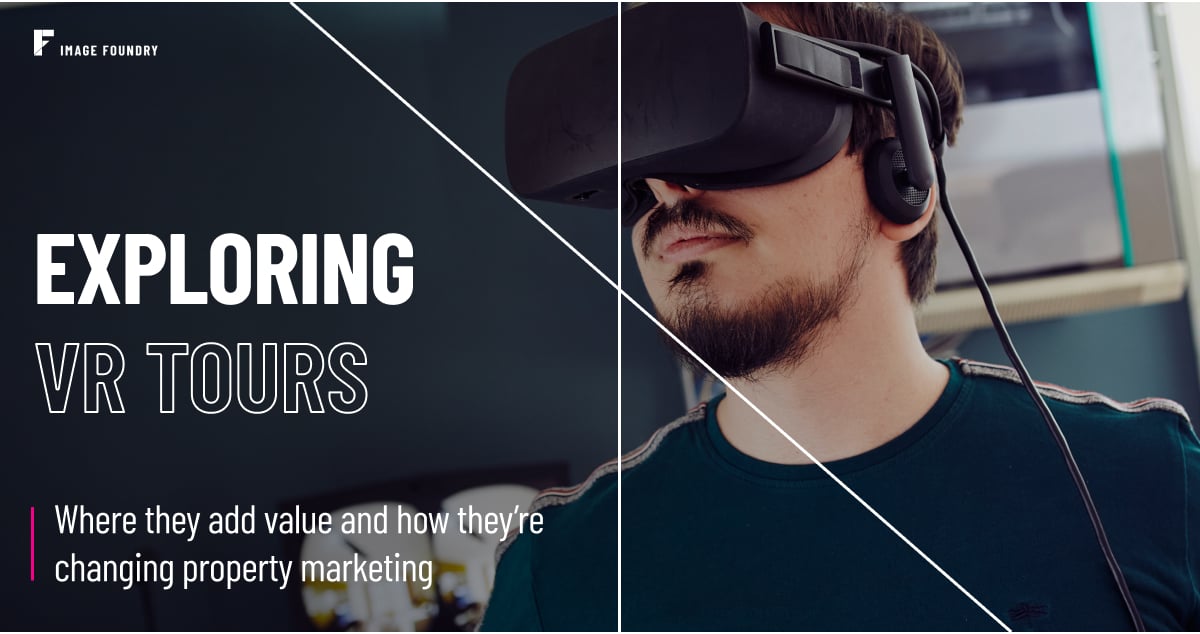
The rise of virtual reality
Virtual reality tours are an increasingly popular way to market new-build properties, so we wanted to take a look at the pros and cons of using them compared to other marketing content – using buyer surveys, developer interviews and our perspective as a CGI company to offer a range of insights on the subject.
What this article covers:
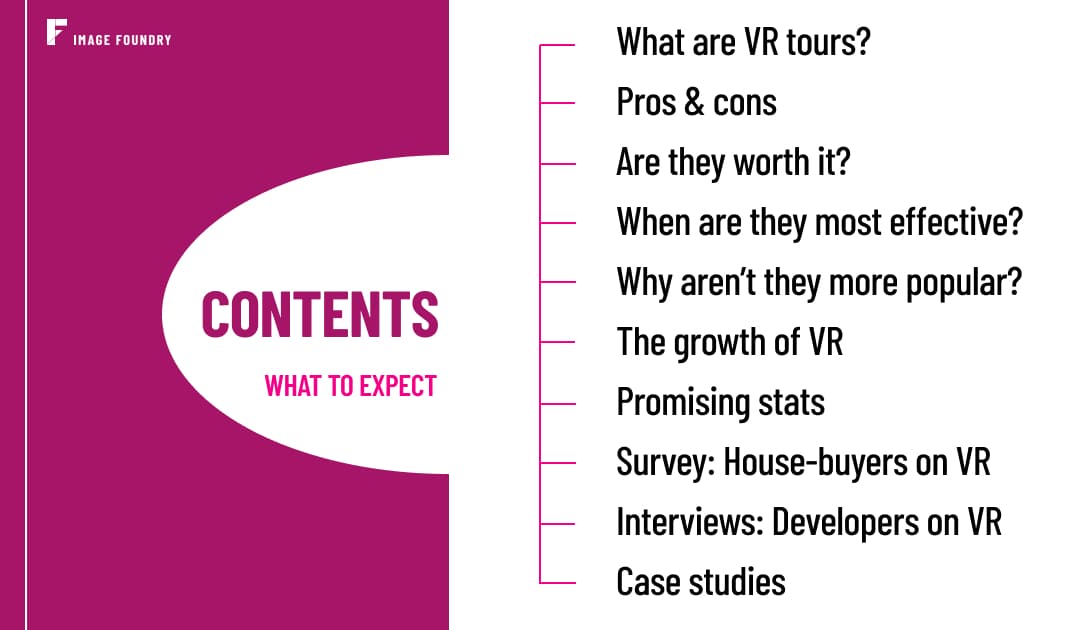
WHAT ARE VIRTUAL TOURS?
On the simplest level, they are a piece of media that allows people to browse properties or places interactively online, or through a piece of software. They’re becoming increasingly popular, whether it’s giving a destination preview through VR tourism or helping people walk around virtual museums they may never visit – and here you can see an example of one of our own interactive virtual tours. However, there are different types of virtual tour used for different purposes – so here’s a quick overview:
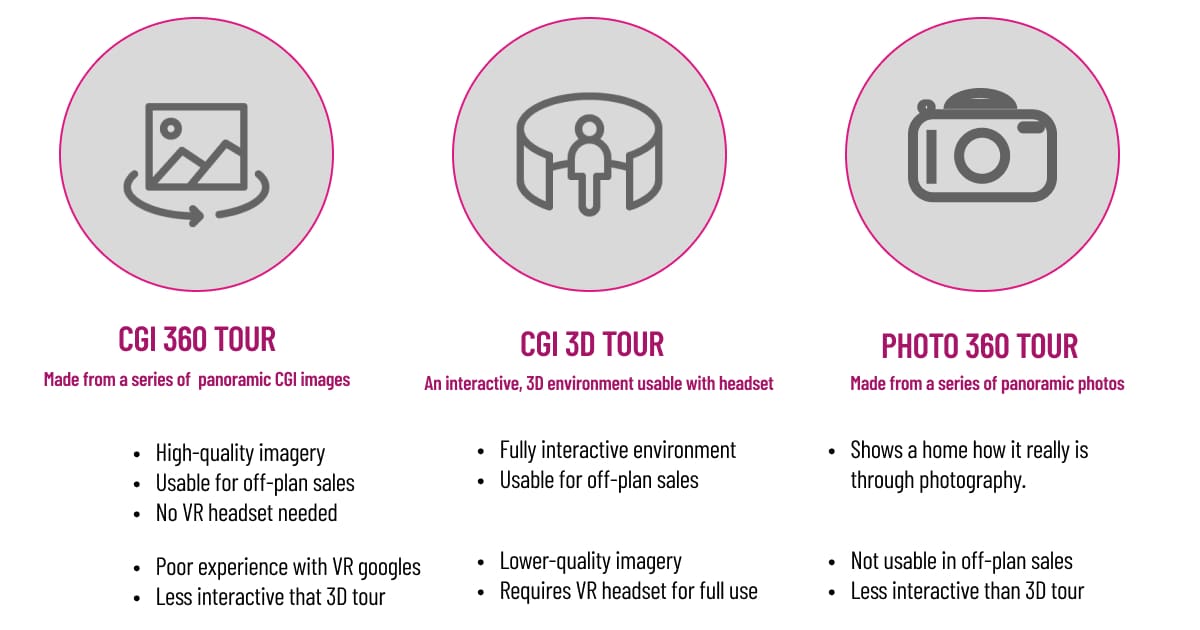
This is where virtual, 360 degree ‘photographs’ are taken of each room using CGI software (like 3ds Max). These are combined to create a single, interactive piece of media. Using a PC or mobile phone, people can click on information points leading them to different rooms in the house, and rotate the view to see all the different angles of each room.
3D tours are similar, except they are made up of a virtual environment that users can explore and interact with much more extensively. CGI virtual tours are made up of 2D images and are awkward to explore using VR goggles, and do not deliver a believable 3D environment. However, 3D tours allow for much more interactivity – there are even more options for changing furniture or appliances in real time. This allows people to explore the environment using a VR headset, in a lower quality but fully interactive 3D space.
Photographic Virtual Tours are used for fully built properties and use real cameras to take 360 degree photographs of the property, and then combine these together to function in the exact same way as CGI 360 virtual tours. The other difference is that these tours can only be done once the property has been fully built and is in a presentable condition – so it isn’t normally used for new-build sales.
This article focuses on the first two types of CGI/3D virtual tour which we specialise in creating, and have researched most extensively.
VR TOURS: THE PROS AND CONS
From CGI images, to photography, to animations – there are numerous ways to market new-build property. So where does VR shine, and where does it fall short? Let’s take a look:
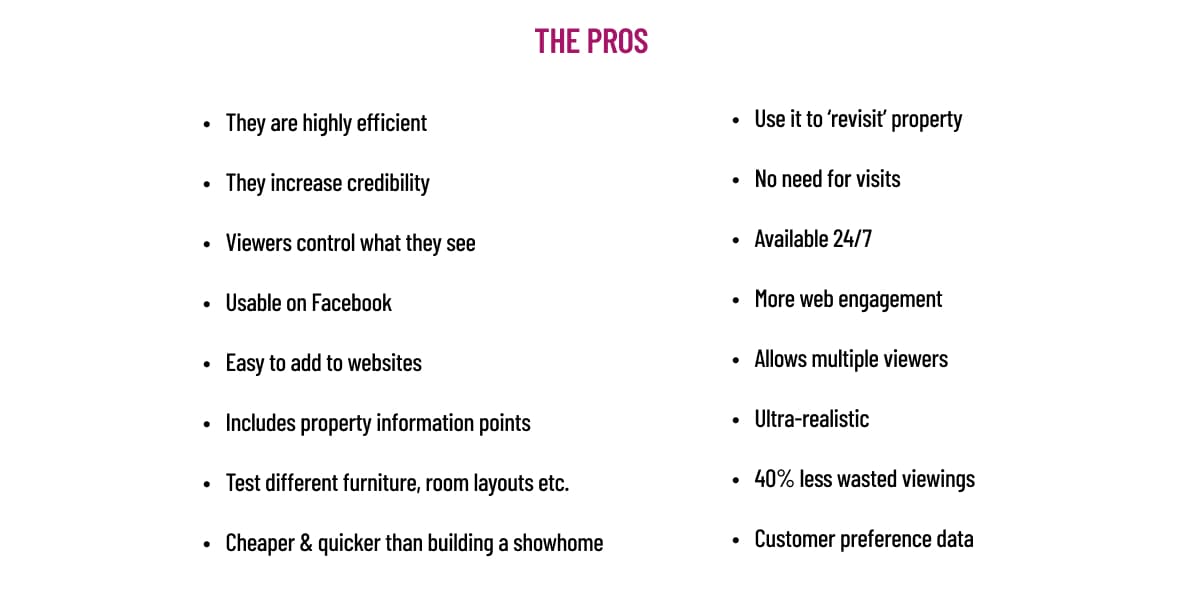
They are highly efficient – VR tours can show off a whole home in one piece of media. Rather than showing lots of CGI images, VR tours capture the whole property in a single piece of media which can be understood as a whole and explored in one take.
They increase credibility – VR tours show that a developer is serious about their new-build homes and is willing to show all of it to customers, helping alleviate buyer concerns about build quality.
Viewers control what they see – Since users ‘click their way through’ the house, they control what they see. Using a VR tour is the closest you come to offering a real home visit where the customer is in control.
Usable on Facebook – VR tours can be implemented on Facebook easily, allowing you to build credibility for your property development on social media (see how you can add virtual tours to Facebook).
Easy to add to websites – Equally, VR tours are easy to add to your website through plugins (for example, the Garden Gnome Package).
They can include information points – For example, information about measurements, appliances, furniture and other home features that help customers understand the property.
Test different appliances, furniture, room layouts – When virtual tours are created, your CGI supplier should be able to offer alternative versions of appliances and furniture to provide alternative room layouts and decorations – especially useful when there are multiple options which customers are able to choose from.
Cheaper & quicker than building a showhome – Virtual reality tours are more expensive than creating still images, but they are a lot cheaper, and a lot faster, than building a showhome for the same purpose. Even more so, they do not require the added logistics and cost of hiring personnel to guide people through the visit. Add to that the fact that there are no cleaning costs, potential furniture breakages or upkeep costs because the property exists virtually.
Revisiting potential – VR tours let customers revisit homes as well as view them for the first time. People rarely visit a home before buying it more than once, but VR tours let people take a second look at parts of a property they want to reconsider.
Ideal when physical visits aren’t possible – If you’re marketing to an overseas clientele, or people who wouldn’t be able to make a physical visit, then virtual tours are the ideal solution. They provide an exhaustive amount of visual information about the property that gives potential buyers a much greater degree of confidence.
Available 24/7 – Unlike a showhome, virtual tours can be viewed at any time of day (or night) on your website – they are the ultimate flexible tool.
Longer dwell time on websites – Websites that include virtual tours on their listings boast a higher dwell time and click through rate. Buyers like to explore virtual tours in detail (explore the stats demonstrating this on Panomatics).
More people can view at the same time – Similarly, virtual tours allow for multiple people – even hundreds of people – to view a property at the same time anywhere in the world. Because it doesn’t physically exist, viewings are much easier.
Ultra-realistic – In 2022, most virtual tours are extremely realistic and are a like for like substitute for seeing the property in person – this is especially the case for CGI 360 virtual tours which are built from high-quality images (rather than 3D virtual tours, which use a more interactive, but lower quality environment).
40% less wasted viewings – As well as being a sales tool in and of themselves, virtual tours help filter customers who are not interested in the property. This means you are more likely to receive higher quality leads when (or if) people do come for a physical visit eventually, leading to fewer wasted viewings (Statistics courtesy of Property Week )
Discover what people actually want – VR tours allow you to collect simple (but powerful) data about your homes and your customers. For example, if you are testing multiple room layouts, appliances and furniture types – you can record which ones are preferred and market the most effective ones in response. Learn more about the kind of data you can collect here.
Summary: VR tours are a holistic piece of media, ideal for showing off a lot of property information in one place. Unlike other forms of CGI, they lean towards showing off detail while putting the viewer in complete control.
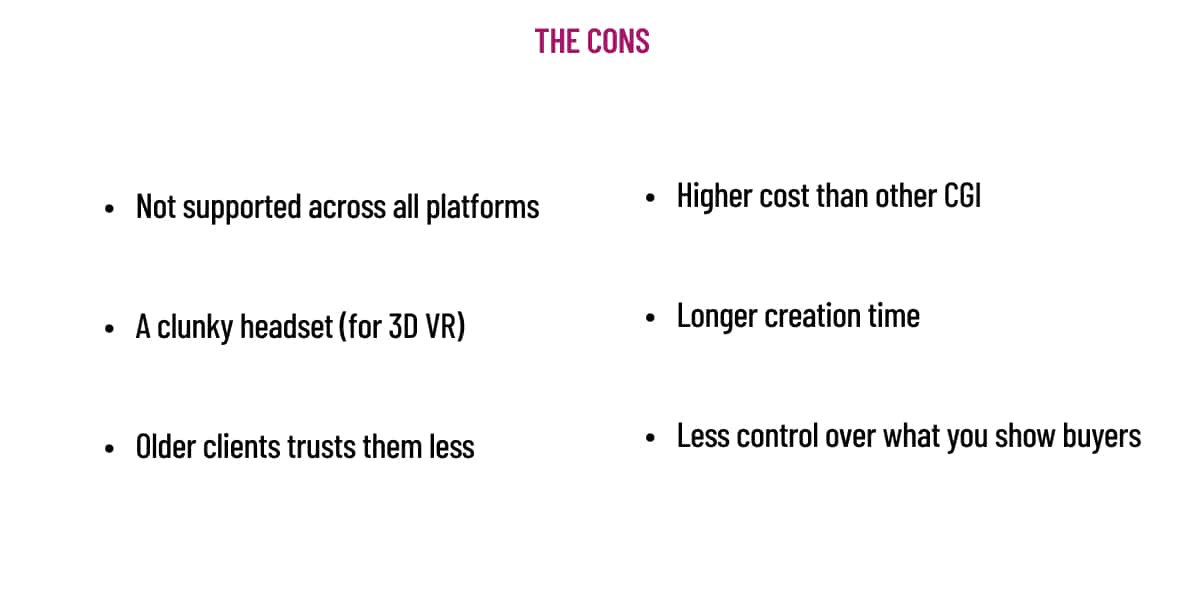
Higher cost than other CGI – VR tours are more expensive than several CGI images, though they are usually a lot less expensive than a full length marketing animation.
Longer creation time – Similarly, VR tours take longer to create than CGI images. We find they average about 1 month to create, depending upon the size and complexity of the property. However, this is less than full length animations (which can take 3-4 months to produce).
Less control over what you show buyers – The beauty of CGI images and animations is that you have complete control over what you show potential customers. You choose the angles, weather, time of day, propping etc. However, VR tours show off every section of the home so you need to be confident that this is something you want customers to see before commissioning a tour.
Not supported across all platforms – Twitter, Instagram and LinkedIn don’t yet allow you to embed VR tours into your social media posts. By contrast, all these platforms allow you to use images and animations. This makes virtual tours less versatile than other CGI because they can’t be shown across all your social channels.
A clunky headset (for 3D VR) – When it comes to VR that incorporates a headset, many people are more resistant and less appreciative. While this creates an added dimension of realism, it also adds the need to physically go to a developers’ sales centre and use the headset. This needs to be weighed up as a cost/benefit before it’s commissioned. For example, recent studies show high levels of resistance to headset usage – see here).
Appealing to older clients – While VR content is appreciated by a younger market, this isn’t so much the case with older clientele. This is significant, because older clients are often those who have the money to buy more expensive, custom properties (the sector in which VR is used the most). These statistics on VR explain further differences between generational usage of the tech.
Summary: VR tours contain a lot more visual media than most other property marketing content – and therefore take longer to create with a higher cost and less control over what you show buyers. It’s worth saying that VR tours are never used on their own – developers nearly always commission supporting CGI imagery or animations alongside them. This is mostly a practical reason, because not all platforms support VR (Like Rightmove and Zoopla) and images/animations are much easier to show. Also, unlike VR tours, images and animations give the developer power to show off the angles they want on a given property.
If you think VR doesn’t suit your property marketing needs, take a look at alternatives to VR here: CGI Stills & CGI animations.
ARE VR TOURS WORTH IT?
It’s best to weigh them up against similar alternatives: animations and show homes.
Both these other mediums are a way to show off the whole property, but VR tours have significant advantages against these two options. In our view, these are the two most significant advantages drawn from our list of pros and cons.
Animations and showhomes are excellent sales tools, but they’re both very expensive. In our experience, animation costs average about £10k+ and showhomes are much more than this. By contrast, VR tours commonly cost around £3k+ for an average house type.
Animations can take 3-4 months to create and showhomes obviously take even longer. By contrast, a VR tour usually takes a month or so to make (for 3D tours/CGI 360 tours).
WHEN IS IT MOST EFFECTIVE TO USE VR TOURS?
There are four main situations where VR performs best and fully masters its ability to capture a whole property in one sweep.
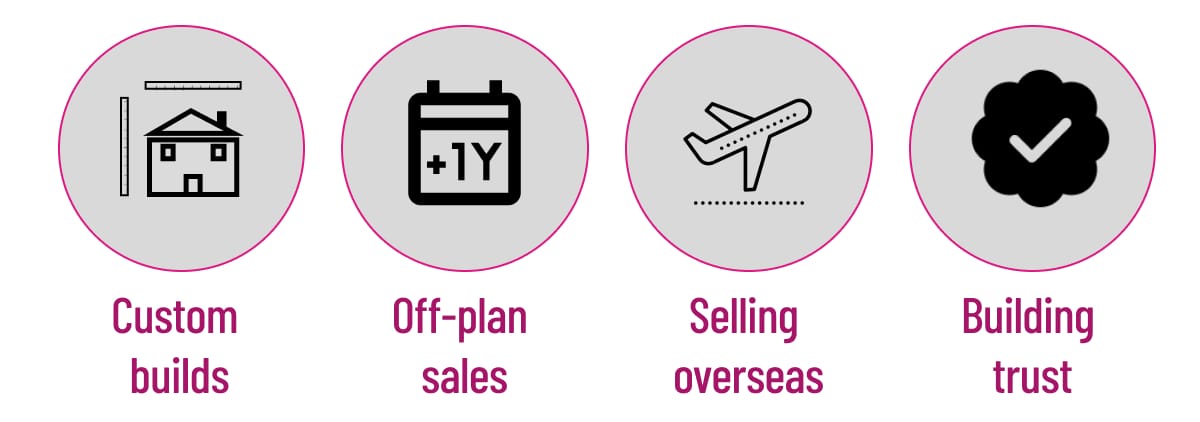
Off-plan property sales
We touched on the fact that 3D/360 VR tours cater to the new-build market in which properties are sold before they’re fully built, or even before they’re built at all. They offer photo-realistic views of somewhere that does not yet exist. For this reason VR tours are ideally suited to any developer who intends to sell properties off-plan, which likely can’t be viewed in any other way.
Custom-build homes
For custom builders, VR can be cost-effective and extremely useful for demonstrating what a property would look like. For example, using the most immersive 3D VR with a headset means that customers can:
VR tours give custom builders the flexibility they need to help customers understand what they want, and exactly what they will be getting well in advance. This also wards off potential issues where the customer may not find the finished product as they imagined it. Not only that, but it directly builds upon the experience of customers planning their own home, giving them a sense of autonomy and putting the product (virtually) ‘in their hands’ – making it a very powerful sales tool.
An overseas market
A more practical usage is when a property developer plans to sell homes to a foreign market. Considering that some customers may not be able to physically view these homes, VR tours become a practical solution to the problem. This is a more niche usage because those who buy homes in this manner are most likely to be investors or wealthy clients who aren’t anxious about buying a property before viewing it.
As a credibility boosting tool
Selling new-build property is not always easy because of the raft of bad press surrounding build quality, cramped rooms, hidden costs and developers who just don’t deliver – buyers need to weigh up a series of pros and cons. For this reason, developers need to find sales tools which increase the credibility of their development, especially if they are a lesser known house builder (or a larger one with a mixed reputation). For this reason, VR tours are a safeguard against people’s suspicions about new-build property. The fact that they allow customers to view the whole property on their own terms is a great way to increase their confidence. This sits in contrast to animations or CGI images, in which the developer/CGI creators choose the best angles of the property to show the customer.
WHY AREN’T VR TOURS MORE POPULAR?
Despite the many advantages of using VR, it isn’t used that often by developers (though usage is increasing). There are two main factors driving this:
Large house builders feel they don’t need it
Perhaps the primary reason is that the largest housebuilders often only build a reusable set of house types. By extension, this means that they would only need a couple of VR tours to show off a huge range of houses. Equally, many of them are able to absorb the larger cost of building a showhome, so they do this instead, because it is a long established practice.
It’s a larger cost for custom builders
On the other hand, custom builders (and smaller house builders) weigh up perceived costs very carefully. While they’d benefit the most from VR tours, they are also aware that CGI images are much quicker to create and can also achieve a high level of quality at a lower cost. Unless they know they have time to wait for a virtual tour to be created, or have made a deliberate space in their budget – many opt for cheaper alternatives. This is unfortunate because this section of the market can make the most out of virtual tours, because, by definition, they offer customisable properties to clients who would be keen to see them in detail before they are built.
The growth of VR in a cost-conscious market
However…with rising construction and material costs in 2022, we predict that housebuilders are going to need to cut costs and double down on investments in high quality marketing materials, as properties become harder to sell. This could well look like more developers abandoning showhomes for VR tours which are far, far cheaper to produce (and maintain). There is also a wider issue: many developers and marketing professionals recognise that the UK housing market is technologically behind and slow to adopt new technology (more on this later). One developer we interviewed said:
‘I think [VR] is the future … because if you go to international sales centres in New York or Shanghai or even in mainland continental Europe. They’re leagues ahead in terms of their technology, whoever said that the property industry is slow was an understatement.’
Perhaps a change in the market will push developers to adopt a technology that is fully viable, cheaper and easy for customers to use.
PROMISING STATISTICS FOR VIRTUAL TOURS
Coldwell Banker surveyed 3000 people on their thoughts about VR usage in the property market, and their responses were overwhelmingly positive. While there is no distinction made between the specific types of VR, it is clear that there is a strong demand for it overall.
Source found here.
Additionaly, the prestigious National Association of Realtors predicted that VR tech would be amongst the most influential pieces of new technology emerging in the property sector over the next 2 years:
“respondents believed that the most impactful emerging technologies to their businesses will be drones (37 percent), cyber security (34 percent), 5G (31 percent), and virtual reality (30 percent).”
(Source here – taken from a survey of 3104 realtors in 2021.)
Virtual tours for business premises
VR tours are excellent for multiple property types, including for business offices and premises – not just family homes. This is exactly what Google discovered during their survey of VR usage. Here are some highlights:
View more statistics from this study here and here
INDEPENDENT RESEARCH: WHAT HOUSE-HUNTERS THINK OF VIRTUAL TOURS
We did some research with Lancaster University to find out what people thought about VR tours, and whether they were a worthwhile tool to use. The results show a general appreciation for VR tours, but with a (much expected) preference for a physical viewing when given the option:
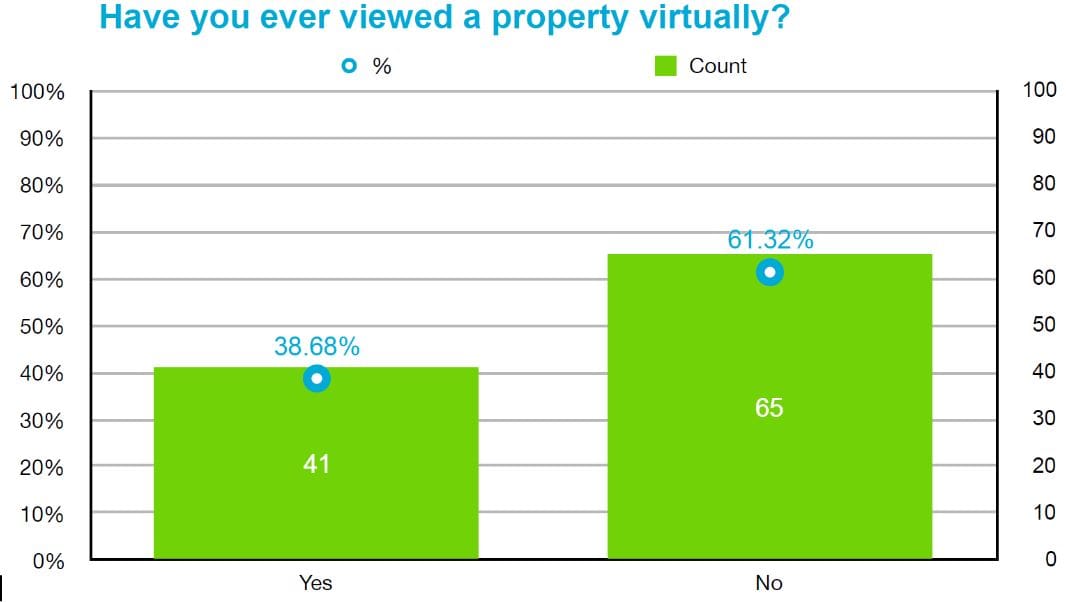
Most people had not viewed a property virtually, indicating that VR tours remain a less common form of visual property marketing, despite the pandemic.
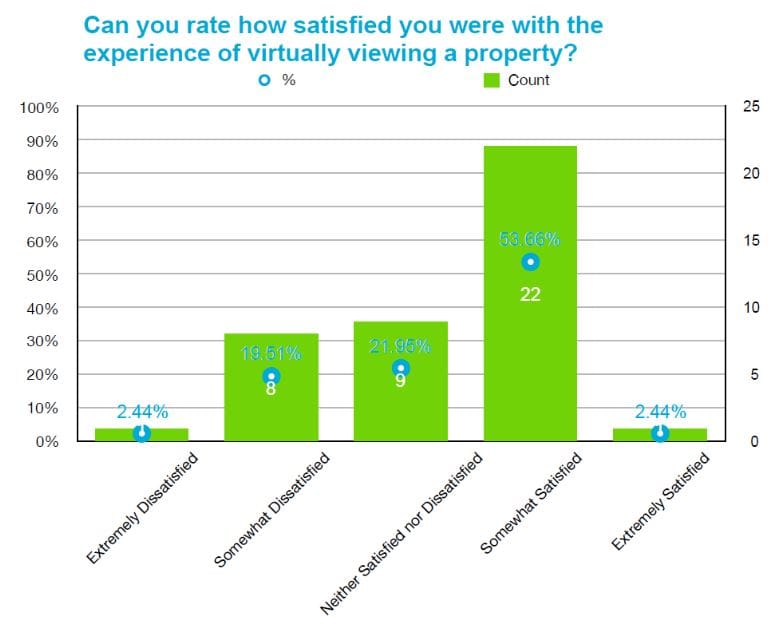
Of those who viewed homes virtually, more than half were satisfied and just over 20% were not, with a nearly equal percentage undecided.
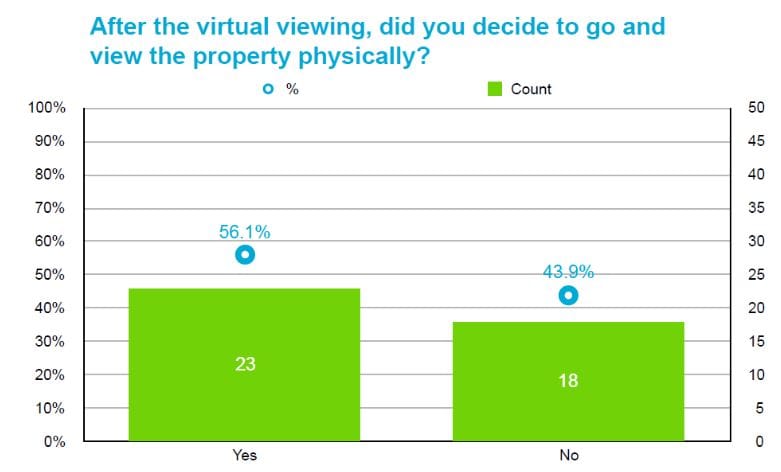
The relatively even balance between virtual and (subsequent) physical viewing indicates the two work together to give an impression of a property.
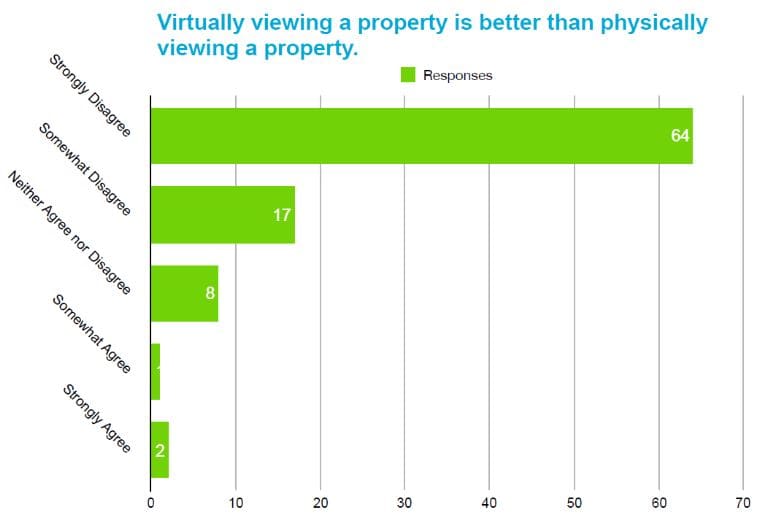
However, when asked to show a preference, people still very strongly favoured physical viewings – when these were possible and available to them.
What these statistics mean
Buyers are mostly appreciative of virtual tours, but also use them in tandem with physical viewings where possible. The lack of negative feedback implies that this is a very useful tool in the right context, with plenty of room for growth as technological capacity increases and there is greater customer awareness.
PROPERTY DEVELOPER PERSPECTIVES ON VIRTUAL TOURS
During another research project with Lancaster University, we interviewed several developers to find out their perspectives on a range of topics – including VR Tours (you can view the full results of our interviews here). This wasn’t on our list of topics to discuss, but almost every developer raised it as a point of interest, showing that there is a growing awareness of VR tours and how they can be used.
Key quotes from developers:
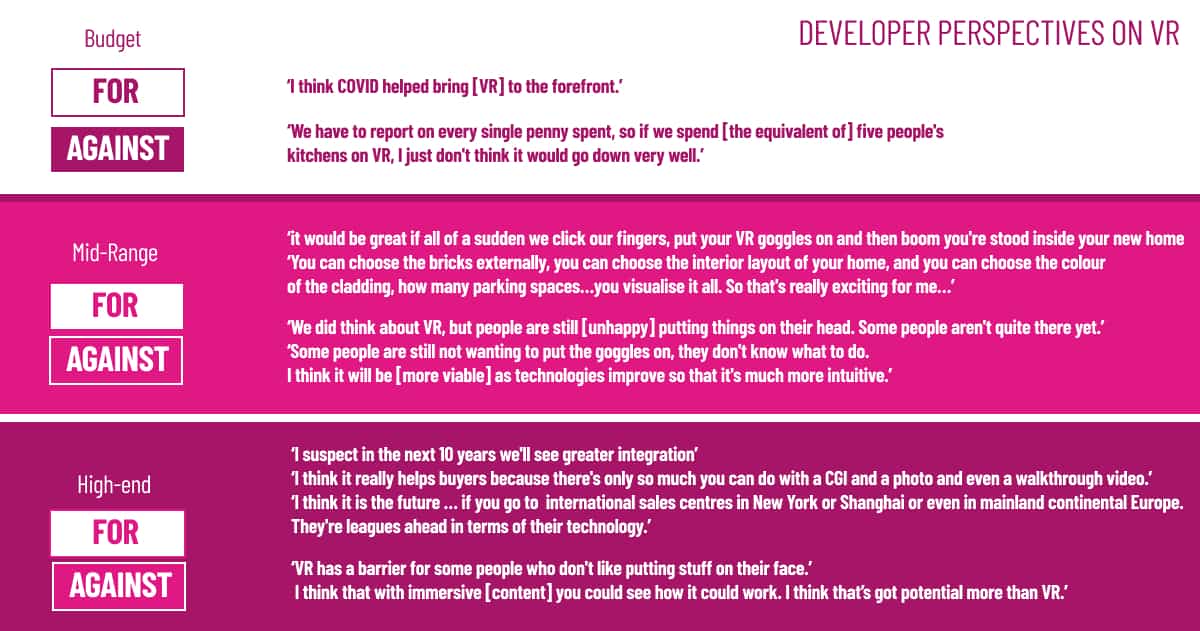
Main takeaways from developer interviews:
These developers (and others not quoted here) were largely positive about VR and strongly anticipated that as technology improves, it will become an essential marketing tool for property developers at a cheaper cost and with quicker rendering. The overwhelming response was positive, with developers keen to use this technology despite the current barriers and problems with usage.
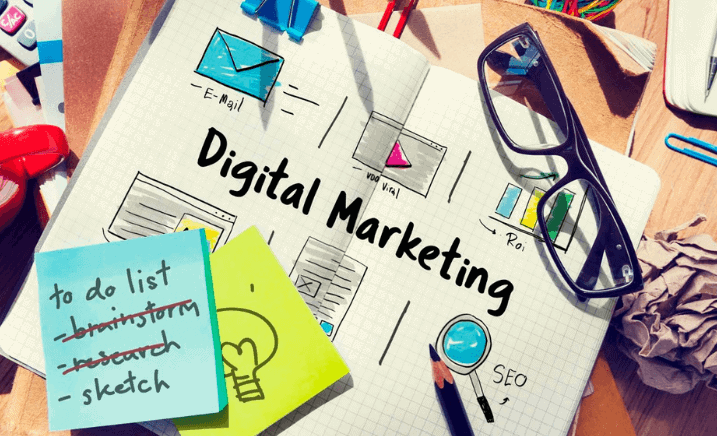
Is less really more when it comes to pr...